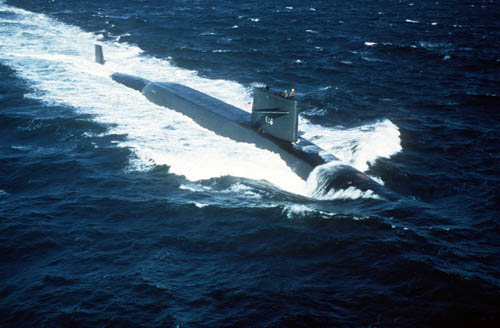Lafayette-class (SSBN-616)
Summary
| Origin country | 🇺🇸 United States |
| Category | Submarine |
| Subtype | Nuclear ballistic missile submarine |
| Manufacturer | General Dynamics Electric Boat, Mare Island Naval Shipyard, Portsmouth Naval Shipyard, Newport News Shipbuilding and Drydock Company |
| Year commissioned | 1963 |
| Units | SSBN-616 LAFAYETTE, SSBN-617 ALEXANDER HAMILTON, SSBN-619 ANDREW JACKSON, SSBN-620 JOHN ADAMS, SSBN-622 JAMES MONROE, SSBN-623 NATHAN HALE, SSBN-624 WOODROW WILSON, SSBN-625 HENRY CLAY, SSBN-626 DANIEL WEBSTER |
Description
The Lafayette class was a significant development in the United States Navy's fleet ballistic missile submarines, evolved from its predecessor, the Ethan Allen class. Launched to enhance the U.S. nuclear deterrent force, the Lafayette class was part of the strategic "41 for Freedom" submarines, which served through the late 1980s, alongside the George Washington, Ethan Allen, James Madison, and Benjamin Franklin classes. These submarines are sometimes grouped with the James Madison and Benjamin Franklin classes in military references.
Design improvements included larger size and general enhancements over its predecessors. Initially, the first eight submarines were equipped with the Polaris A-2 missile and later upgraded to the longer-range Polaris A-3, with the USS Daniel Webster starting with the Polaris A-3. The mid-1970s saw a further upgrade when the submarines were fitted with the Poseidon C3 missile, which was specifically designed to leverage the larger missile tubes of the Lafayettes. Unlike some in the James Madison and Benjamin Franklin classes, the Lafayette-class submarines were not refitted with Trident I (C4) missiles. They were equipped with a hovering system that increased missile firing rate from one to four missiles per minute.
Operational history saw the Lafayette class serving during a critical time in the Cold War, but they were decommissioned between 1986 and 1992. Factors contributing to their decommissioning included strategic arms reduction due to SALT II treaty limitations, the introduction of the Ohio class SSBNs, the submarines' ages, and geopolitical shifts such as the collapse of the Soviet Union.
Technical specifications
| Lafayette | |
|---|---|
| Displacement | 7370 tons |
| Displacement submerged | 8380 tons |
| Crew | 140 members |
| Width | 10.0 m (32.8 ft) |
| Length | 130.0 m (426.5 ft) |
| Max. depth | 396 m (1299.2 ft) |
| Propulsion | 1 General Electric S 5W reactor with a power of 30,000 hp - 1 propeller |
| Armament | 16 UGM-73 Poseidon missiles + 4 533mm TLTs |
| Maximum speed | 16 knots |
| Max. speed submerged | 25 knots |
Photo of Lafayette class
